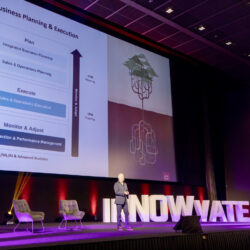Mestergruppen: successful implementation thanks to perfect preparation

Norwegian DIY retailer Mestergruppen has successfully implemented Blue Ridge’s supply chain software. The investment has already almost paid for itself after just eight weeks of operation. During a webinar by Supply Chain Media and Blue Ridge, Ove Berger from Mestergruppen explained what made this project so successful: “Our approach made it very easy to select the right software vendor.”
By Marcel te Lindert
Mestergruppen is Norway’s largest supplier of building materials. Besides supplying to construction companies, the company also has 420 do-it-yourself (DIY) stores in Norway and Sweden. Mestergruppen has grown rapidly in recent years, partly through acquisitions, which has resulted in a fragmented IT landscape. “Our IT director recently said that he has stopped counting our ERP systems,” chuckled Ove Berger, senior supply chain specialist at Mestergruppen.
Despite that fragmentation, Mestergruppen has successfully implemented Blue Ridge’s supply chain software. According to Sverre Rosmo, general manager of Blue Ridge in Scandinavia, that success didn’t happen by chance: “It’s not just a matter of good or bad project management. A software implementation entails a large number of consecutive steps and involves almost the entire company. If any of those steps aren’t taken seriously enough, it can jeopardize the entire project and even the company’s future.”
Analysing problems
The project started with the observation that Mestergruppen’s retail division was struggling with various problems. The company spent a lot of time on analysing those problems. “We had no control over the service levels and stock levels. We had the feeling that the inventory was out of balance, but we didn’t know by how much, plus we had too many out-of-stock situations. All this had an impact on our market reputation, on our financial standing and on our supplier relationships,” said Berger.
Mestergruppen quickly realized that none of its existing ERP systems offered the right functionality to gain a better grip on service levels and inventory, and adding even more detail to its spreadsheets would not be a viable solution either. The alternative was to implement a best-of-breed software solution from a vendor with the relevant expertise. But before the retailer started looking for a suitable software partner, it first carefully evaluated its needs.
No chance of being distracted or misled
One key need was to optimize procurement and supply. Rather than having a single central distribution centre for all 420 stores, Mestergruppen operates several warehouses that purchase stock separately from at least a hundred different suppliers. “First of all, we wanted to maximize the efficiency of the procurement operation. In addition, we noticed that suppliers were organizing delivery rounds to our various warehouses, but Purchasing didn’t take that into account. So we looked for ways to combine all the different purchase orders into full truck loads,” explained Berger.
Another need was multi-echelon inventory optimization and classification of items based on criteria such as turnover rate. “We translated these needs into concrete use cases that we tested with the future users in our various warehouses. We wanted to be sure that we had mapped out the needs in sufficient detail. Additionally, we knew that some software vendors would try to tempt us to invest in different solutions and we didn’t want to be distracted or misled.”
Presentation of 15 scenarios
Mestergruppen invited a number of software vendors to pitch their solutions, and the company learned a lot from that exercise according to Berger: “It helped to further intensify the focus on our needs. But to be honest, all the software vendors’ stories sounded too good to be true. There seemed to be endless possibilities. The standard demos didn’t give us clarity, so we prepared 15 different scenarios that illustrated our problems.”
The company presented the scenarios to a shortlist of software vendors and asked how their software could handle them. Berger’s team worked with the future end users to quantify, evaluate and rank the responses based on a scoring system – with surprising results: “It turned out that we had one clear winner, so our scenario-based approach actually made it very easy for us to select the right software vendor.”
Detailed project description
Proper implementation is at least as important as the right software, if not more so. Therefore, before sealing the deal, it is wise to ask software vendors about their implementation approach. You should request a detailed project description including the methodology used, the time frame, which parties will be involved and an estimate of the workload – not only for the software vendor, but also for any other parties involved and, of course, your own company. “If a customer doesn’t ask us for this, it’s our moral duty to bring it up,” said Rosmo. “This also exposes any problems at an early stage. A software vendor can’t expect every company to know what’s involved in a project like this.”
Another consideration before actually signing a contract with a vendor should be the continuous development of the software. After all, the solution is not just for today; it should remain satisfactory in the future too. It is therefore important to know what the roadmap looks like. “And will new functionality be made available automatically, or will you have to pay extra for each update or expansion?” asked Berger. “For us, it was important that we can integrate Blue Ridge’s software with different ERP systems in the future and use it elsewhere.”
Payback within eight weeks
Additionally, successful implementation depends on commitment from within the company: from the shareholders who are financing the project and the managers who are responsible for it, all the way to the end users who have to work with the new solution. In order to gain commitment, it helps to define concrete goals and to provide insight into the return on investment (ROI). Berger: “I hardly dare say it out loud, but we have almost earned back the investment after just eight weeks of operation. We’ve reduced our inventory value by more than 11% while our service level – which was already above 97% – has risen by 1%.”
Berger and Rosmo agreed that the project-based approach has been a key success factor. They are both advocates of the army motto: ‘Perfect project preparation prevents poor performance’. As part of this, all decisions and the subsequent actions are recorded so that everyone’s responsibilities are clear. Another success factor has been the preparation of use cases for the end users, which has ensured the necessary support. “And then there’s training, training and more training,” added Berger. “It’s best to leave that to the vendor, who is the specialist after all. Even if you yourself have sufficient knowledge about how to use the system, that doesn’t mean you’ll be good at teaching others.”










